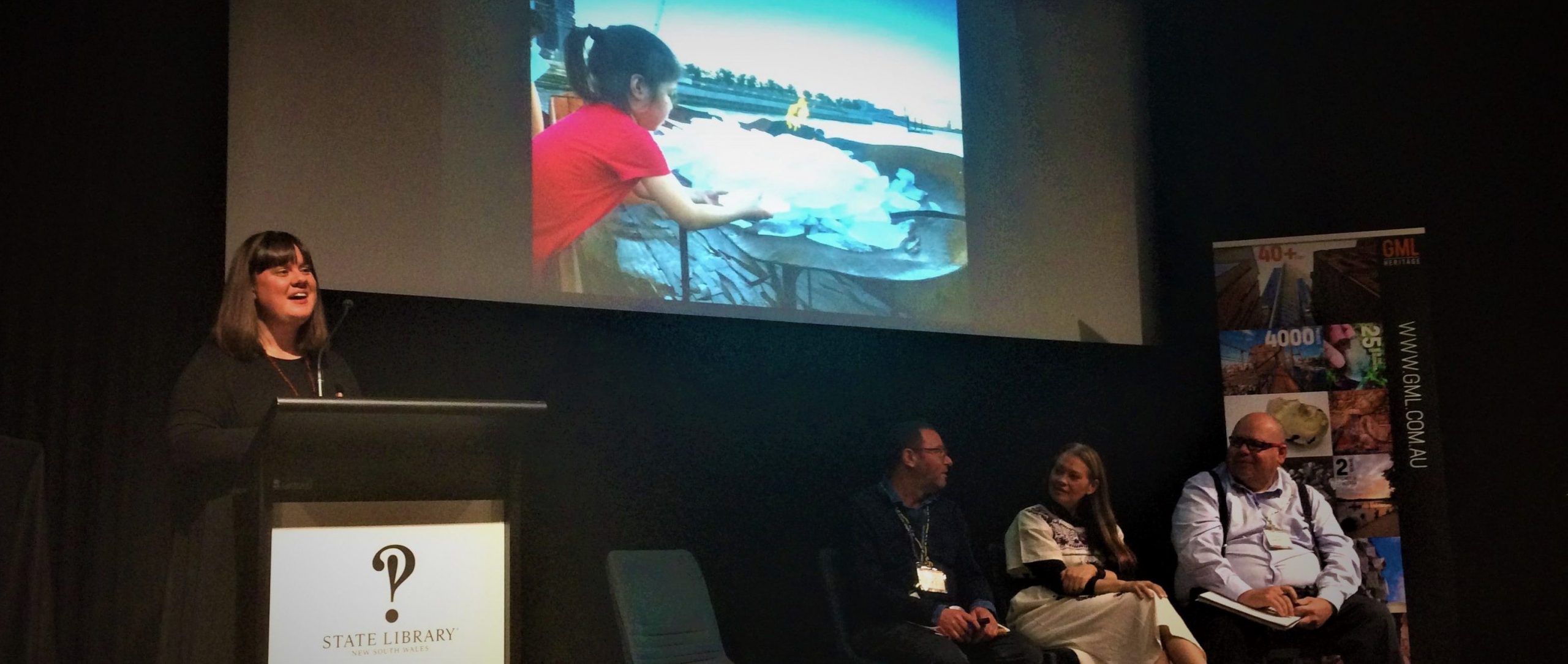…by Minna Muhlen-Schulte, who chaired a panel on Indigenous history making at the recent PHA national conference, Marking Time.
PHANSW was proud to present a panel by some of Sydney’s leading Aboriginal curators and cultural strategists – Ronald Briggs (Curator of Research and Discovery at State Library of NSW), Melissa Jackson (Indigenous Services Unit, State Library of NSW), Emily McDaniel (freelance curator for Museum of Contemporary Art, Biennale of Sydney and Art Gallery of NSW) and Peter White (Head of Indigenous Strategy and Engagement, Sydney Living Museums). The panel provided a thought-provoking discussion on interpreting Aboriginal history in the public sphere.
Emily McDaniel demonstrated how her project 4000 fish, inspired people to engage with story of Barangaroo as an Eora fisherwoman instead of thinking of the name as an embattled urban development. McDaniel curated four Aboriginal artists’ works including a large scale nowie/nawi bark canoe by Steven Russell, to bring together an interactive installation. Participants were invited to symbolically return to Barangaroo and her fisherwomen, the 4,000 fish excessively hauled by British colonists on one day in 1790. Audience participants scooped harbour water into cast moulds that after refrigeration created ice fish. People then placed these fish on the fire burning in the canoe. McDaniel talked about temperature, seasons, texture and sculpture as compelling ways for audiences to feel and imagine stories of the past. She also observed that the power of installations like 4000 fish was drawn from their temporality rather than the static way history can be commemorated in bronze, to be walked past and forgotten on a sidewalk. Instead, the 4000 fish ‘put history into people’s hands’. McDaniel touched on the complexities she encountered as Wiradjuri woman telling the stories of Eora people, inviting our profession to understand the nuances of Aboriginal identity within Australia. She spoke from the standpoint of an artist not an historian but argued convincingly for collaborations that help audiences interpret and reflect on history.
Ronald Briggs and Melissa Jackson discussed the State Library of NSW’s Indigenous collection strategy, which now has a focus on Indigenous-created material. Their approach is to get the community to engage with the collections, including by inviting people to identify Aboriginal people represented in the archives, for example in the library’s collection of Barbara McGrady’s portraits of families at the Koori Rugby League Knockout. Brigg’s spoke enthusiastically about the recent acquisition of a portrait of a young man at Parramatta named Toulgra (also known as Bull Dog) by Nicolas-Martin Petit, an artist on French explorer Nicolas Baudin’s expedition to Australia. Detailed portraits of named Aboriginal people in Sydney from this time are very rare.
Melissa has a special interest in Aboriginal languages. She talked about The Rediscovering Indigenous Languages project, which aims to preserve and revitalise some of the oldest languages in the world by digitising Indigenous word lists, language records and other cultural documents, starting with the State Library of New South Wales’ collections.
As chair of the session Peter White asked the panel and the audience to consider the challenges of working as an Aboriginal curator within traditional colonial institutions: ‘it’s an uphill slog in bastions of memory to get an Indigenous world view’, he said. And now that he is finally learning his Gamilaroi language, he is realising too that the language used to interpret the past reflects ways of thinking about that history. Peter invited us to continue the conversation with Aboriginal curators and communities to help us all reach a level of maturity that allows for truth telling and for creating a shared history.

Thanks for the report Minna, this was such a powerful and interesting session at the conference.